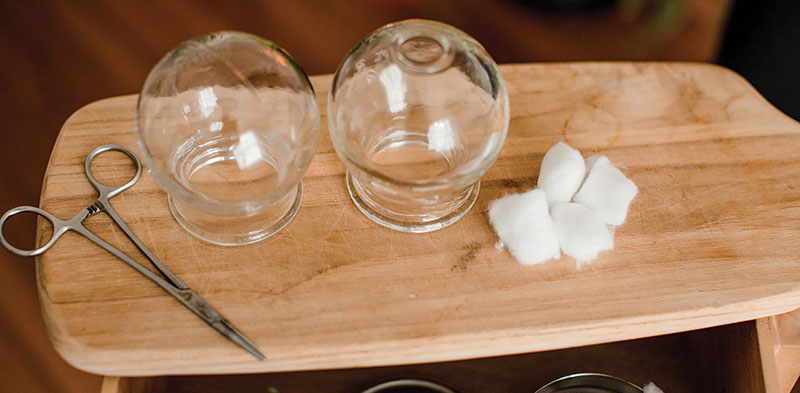By Natasha Kubis
When Olympic Gold Medalist, Michael Phelps, appeared in photographs sporting red circular marks all over his body, people questioned if he had been in an altercation with an octopus. In recent years, celebrities and athletes alike have brought the ancient art of cupping therapy to the public eye, making it more mainstream than ever before.
Cupping may be trending at the moment but it is in fact a universal therapy practiced by many cultures around the world. It can be traced back to ancient Egyptian, Chinese, and Middle Eastern times, and as early as 1550 BC. It was prescribed for various ailments in the records of Herodotus, Hippocrates, Celsus, and Aretaeus. Its roots can be found in the ancient healing systems of Tibetan, Oriental, and Ayurvedic medicine (traditional Indian medicine), as well as Unani (a South Asian and Middle Eastern folk medicine).
As ancient and widely used as this technique is, it is widely misunderstood in our modern culture and the marks that it leaves on the skin can make people quite apprehensive, understandably so. Having some knowledge about the technique may help transform it into a viable option to treat your aches and pains.
What is cupping used for?
Cupping is effective for relieving pain, relaxing muscle spasms, increasing local blood circulation, and detoxifying local tissues. It can increase range of motion in the joints, and promote flexibility in the ligaments, tendons, and in-between muscle layers. It is most effective for neck, back, knee, and elbow pain, as well as for conditions like tendonitis, sciatica, tension headaches, migraines, fibromyalgia, and arthritis. It can be used for bronchial congestion caused by allergies, asthma, and the common cold.
How does it work?
There are several cupping methods. A traditional technique used by practitioners of Chinese Medicine is called Glass Jar Fire Cupping. The practitioner will light a cotton ball on fire and use it as a heat source to warm the glass cup and to remove the oxygen from inside of it. The cup is then placed on the skin and as the air inside of it cools, a vacuum effect causes the blood vessels to expand and the skin begins to rise.
More modern versions of cupping methods used by massage therapists, physical therapists, chiropractors, or for home use do not use fire, but instead, create the vacuum effect with glass, bamboo, earthenware, or silicon cups that are moved across the skin, or remain stationary.
Is it similar to massage?
Cupping has a similar effect on the body as massage except that cupping uses suction or negative pressure rather than the tissue compression used in massage techniques. The suction stretches the tissues up from the underlying structures, thereby releasing muscle tension and loosening areas of restriction. This creates an expansion of the tissues while increasing blood flow, promoting better functioning of sweat and sebaceous glands, flushing capillary beds, and dispelling stagnation and congestion.
How does it affect the skin?
The suction of the cups often leaves temporary marks on the skin. The marks resemble bruising, but are not painful. They are the result of bringing blood and toxins to the skin’s surface. The color of the marks can range from light pink to dark purple, depending on your condition. The marks can last from about 3 to 10 days. To help reduce this duration, it is recommended to drink plenty of water after your treatment.
Does it hurt?
No, it does not hurt. Most people find it relaxing and feel a warm suction, as though their skin is being lifted.
How many treatments will you need?
The effects of cupping are cumulative and the treatment should be repeated until the ailment is resolved. The severity of the marks will usually diminish with each follow up treatment, indicating that the stagnation in the tissues has decreased.
Are there any risks associated with the technique?
It is important to see a licensed acupuncturist, Doctor of Chinese Medicine, licensed massage therapist, physical therapist, or chiropractor who has been adequately trained in the technique. Do not be shy about asking about their training before booking a session. The risks of cupping are very low with a trained professional who has adequate experience. There are cupping sets available for home use, but it is important to have proper knowledge of safe cupping practices before trying it on yourself or others.
Cupping is contraindicated for those with blood clotting disorders (like deep vein thrombosis or history of stroke), bleeding disorders (such as hemophilia), or those who take blood thinners (such as warfarin). It is not recommended for skin conditions such as allergic dermatitis, psoriasis, or eczema. Cupping is contraindicated in cases of severe diseases such as cardiac failure, renal failure, ascites due to hepato-cirrhosis, and severe edema. Cupping should not be applied over broken bones, dislocations, hernias, and should not be used on the low back or abdomen during pregnancy.
The Takeaway
Cupping is a wonderful option to help ease pain and inflammation, increase blood flow, promote relaxation and well-being by calming the nervous system, aid in detox, and provide a deep-tissue massage. The cupping marks also make for a good story when wearing a bathing suit or a strapless dress!
Natasha Kubis is a licensed acupuncturist and certified yoga teacher.
For more information, visit acuwellhealth.com

